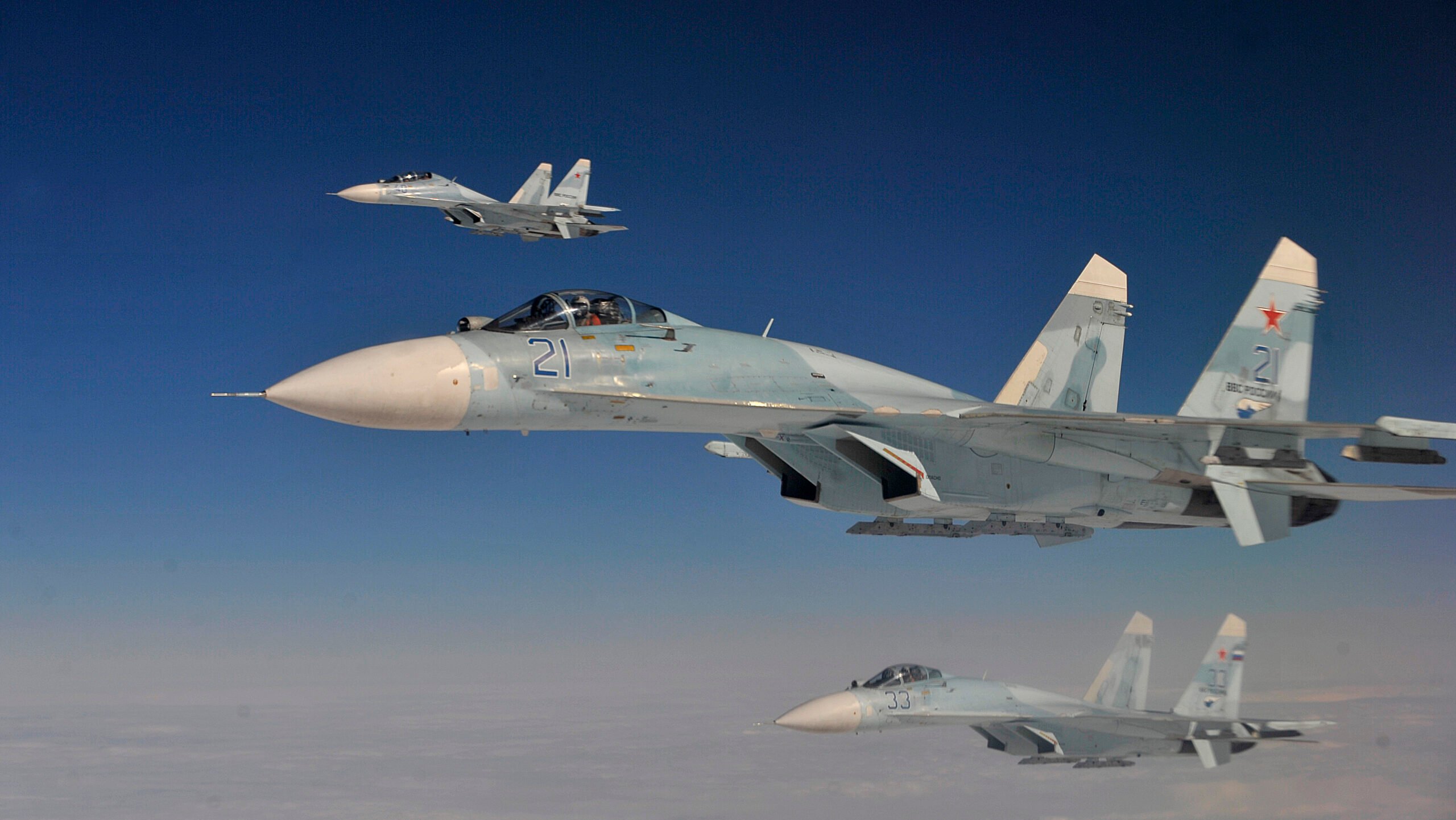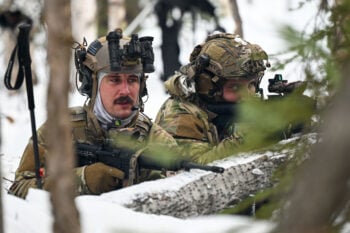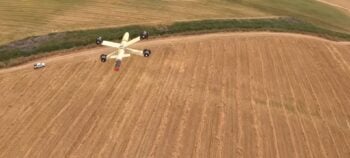
Russian Federation Air Force Su-27 Sukhois intercepts a simulated hijacked aircraft entering Russian airspace, (US Air Force photo by Tech. Sgt. Jason Robertson/Released)
WARSAW — As the ground war in Ukraine continues to grind ahead of the winter months, the Russian Aerospace Forces (VKS) are experiencing falling availability rates with their existing fleet of combat aircraft. The culprit is a combination of a high number of losses of fixed-wing aircraft combined with a drop in mission-capable rates due to the higher-than-normal number of flight hours being flown by those aircraft remaining.
In the UK MoD’s Sept. 28 defense intelligence update on the war, London estimated that since the start of the conflict, the VKS has lost 90 combat air frames. This includes significant numbers of the most modern Sukhoi aircraft models, which have become difficult, if not impossible, to replace. The situation has only grown worse in the weeks since, when it was reported that Russia’s own air defense units had shot down two of their own Su-35S fighter aircraft within a few days of one another.
The first incident occurred on the same day as the initial briefing in London with the downing of the first aircraft near the Ukrainian town of Tokmak, located 20 kilometers (12 miles) behind the Russian forces’ current front line in the Donetsk region. The second Su-35 was lost on Oct. 6, near the Ukrainian city of Mariupol. The pilot is reported to have survived the incident by ejecting. One of the Russian military blogger channels on the platform Telegram commented “at this rate of work of our valiant air defence, we will soon be left without aviation.”
The two incidents represent a serial failure of either the Su-35’s sistema svoi-chuzhoi (IFF) that is produced by the Russian Central Scientific Research Institute of Economics, Informatics and Control Systems (TsNII EISU), or the inability by Russia’s VKS and its air defense units to effectively process the signals emitted by the unit.
Attempts by Breaking Defense to contact the institute revealed that the institute’s website has been shuttered and that its facilities have been closed down as part of bankruptcy proceedings.
RELATED: Ukraine, Israel, submarines: What’s in Biden’s $105B supplemental request
The proverbial fog of war and other complications means a complicated battlefield like Ukraine was always likely to lead to friendly fire. But the number of incidents over Ukraine have been astounding: Data compiled by Newsweek in August found that roughly 20 percent of all aircraft and helicopter losses by the VKS in this war have been due to either their own units shooting them down or as a consequence of poor maintenance or pilot error.
Speaking to Breaking Defense during the Oct. 3-4 Warsaw Security Forum, a NATO-nation military aviation analyst described incidents in which Russian aircraft system failures have prevented what could have otherwise been dangerous confrontations with alliance members or partners in the skies.
“When it comes to the Russian VKS all you can say sometimes is ‘thank God for shoddy maintenance,’” he commented.
Too Many Hours
The other part of the UK intelligence assessment points out that these losses have left a markedly reduced number of strike platforms, particularly the Sukhoi Su-34 medium-range fighter-bomber, available for missions. This has the VKS “flying some of its combat aircraft types far more intensively than in peace time,” reads the MoD briefing.
The resulting accumulation of flight hours on these aircraft are in excess of pre-war projections and makes it “highly likely that with this extra wartime use, Russia is eating into many of its airframes’ lifespans far more quickly than the VKS planned for,” per the analysis. That sustained rate of increased op-tempo hours then creates an increased requirement for servicing of these aircraft. “This need for extra maintenance is complicated by a shortage of spare parts because of increasing demand and international sanctions,” concluded the MoD.
The VKS has already experienced difficulties with shortages of long-range precision-guided munitions, but this more recent reporting now raises questions about long-term availability of the platforms required to launch them.
An August report by RAND revealed the extent to which the hours flown are beginning to take their toll on the VKS fleets. The RAND findings are:
- The VKS is still transitioning from Soviet-era aircraft to more-modern platforms. The current rate of new aircraft coming online is so low that almost half of the fleet are upgraded Soviet-era airframes.
- Modern Russian aircraft are designed for a 3,500 and 4,500 flight hour service life, and some for as many as 6,000. But the Soviet-era platforms were designed for 2,000 to 3,500 hours. Some models, such as the MiG-31, have been upgraded to extend service life, but most of the older models are nearing the end of their service lives with only 500 to 1,000 hours remaining.
- In the first few months of the war in Ukraine, the VKS was flying 150 to 300 sorties per day — compared to peacetime rates of 60 per day. This has since fallen to 100 sorties a day, but this is still nearly double the peacetime number of hours.
- The high flight hours being flown by older aircraft is “equivalent to losing roughly 34 aircraft since the start of the invasion. However, this only captures the losses relative to the life span of newer airframes. Because the older airframes have so few remaining hours, it’s actually equivalent to losing about 57 VKS airframes…This results in total true losses closer to 187 VKS airframes. Extrapolating this, the VKS will continue to lose 30 to 60 airframes a year from combat, accident, and imputed losses.”
- By the summer of 2024, combat losses and imputed flight hour losses may put the VKS below 75 percent of its prewar strength.
The VKS at this point in 2024 will also be facing a different Ukrainian force with more capable air defense systems and Ukrainian pilots now flying US F-16s and the Swedish JAS-39 Gripen. Ukraine defense firms that met at a Sept. 29 forum in Kyiv with some of their EU and NATO-nation counterparts have reported production difficulties experienced by the Russians, some of which predate the February 2022 invasion. While obviously biased, Ukrainian defense industry officials are an important source of industrial information about Russia, given the historical ties between the two sides’ defense industrial bases.
Ukraine defense electronics enterprises recounted to Breaking Defense what was described as a “laborious” process of building major subsystems, like the Sukhoi Su-35’s NIIP N035 Irbis passive electronically scanning array (PESA) radar set. The same radar has also been installed in the early production batches of the Su-57 due to the problems that the NIIP design team have with developing a series-manufacture variant of an active-scanning (AESA) radar.
AESA radars have become the technological gold standard for the sensor and fire control systems on board major Western fighter aircraft but is an area where Russia has lagged. Shortly before the Ukraine invasion, Egypt reportedly cancelled their planned Su-35 procurement due to the lack of an AESA in the aircraft’s export version. The N035 PESA model was said to have been inadequate as it was effectively jammed by the Dassault Rafale’s SPECTRA EW suite designed by Thales in France during test flight evaluations. The Egyptians were flying the F3 version of the Rafale against the Russian aircraft rather than the current F4 configuration.
Another issue facing Russian industry, according to their Ukrainian counterparts, is diminishing supplies of spares for the VKS is largely due to international sanctions that have choked off supplies of foreign electronic components. Compounding the issue, Ukrainian industry sources report that some of Russia’s qualified industry specialists left the country shortly after the invasion and there are few if any replacements for these personnel.
The UK MoD assessment states the “VKS maintains the ability to surge sortie rates over occupied Ukraine,” but this is not sustainable. Their conclusion: “as the war continues much longer than the Russian Ministry of Defence originally planned for, wear and tear of airframes is likely to have reduced the viability of the VKS’s long-term tactical air power.”
The solution, as outlined in a subsequent MoD briefing is for Russia to engage in a spending spree to address deficits in military production across the board. Documents leaked from the Russian Finance Ministry call for the defense budget to increase to 30 percent of all public spending in 2024.
The proposed increase would put Moscow’s military spending to 10.8 trillion roubles (US $110 billion). This would amount to 6 percent of the nation’s GDP and a 68 percent increase over and above this year’s wartime spending. The decision is looked upon as dramatic, particularly as it comes less than two months after an early August decision by Russian President Vladimir Putin to double 2023 defense outlays.
In a public appearance made the week before Warsaw Security Forum conference, Russian Defense Minister Shoigu projected that the war in Ukraine will last at least until 2025.
“Consistent implementation of measures and activity plans until 2025 will allow us to achieve the goals we set,” he said. These “measures,” he explained, included more advanced weapons production and improved training of Russian troops.
TAI exec claims 20 Turkish KAAN fighters to be delivered in 2028
Temel Kotil, TAI’s general manager, claimed that the domestically-produced Turkish jet will outperform the F-35 Joint Strike Fighter.


























